Transcription of Systems engineering implementation in the conceptual ...
1 Systems engineering implementation in the conceptual designphase of 4 MOSTOlga Bellido-Tirado a, Roger Haynesa, Roelof S. de Jonga, Olivier Schnurra, Jakob Walcheraand Roland WinkleraaLeibniz-Institut f ur Astrophysik Potsdam, An der Sternwarte 16, D-14482 Potsdam, Germany;ABSTRACTThe 4 MOST Facility is a very high-multiplex, wide-field, fibre-fed spectrograph system for the VISTA aim is to create a world-class spectroscopic survey facility that is unique in its combination of wide-fieldmultiplex, spectral resolution and coverage, and sensitivity. In such a complex instrumentation project, inwhich design and development activities are geographically distributed, a formal system engineering approachis essential for the success of the project.
2 We present an overview of the Systems engineering principles, andassociated tools, implemented during the conceptual design phase, as well as the Systems engineering activitiesplanned for the preliminary design :4 MOST, VISTA, Systems engineering , requirements, interfaces1. INTRODUCTION4 MOST is a wide-field, high-multiplex spectroscopic survey facility under development for the VISTA telescope ofthe European Southern Observatory (ESO). Its main science drivers are in the fields of galactic archeology, high-energy physics, galaxy evolution and cosmology. 4 MOST will in particular provide the spectroscopic complementsto the large area surveys coming from space missions like Gaia, eROSITA and Euclid, and from ground-basedfacilities like VISTA, VST, DES, LSST and SKA.
3 4 MOST features a degree diameter field-of-view with 2400 fibres in the focal plane that are configured by a fibre positioner based on the tilting spine fibres feed two types of spectrographs; 1600 fibres go to two spectrographs with resolution R>5000 and 800 fibres to a spectrograph with R>18,000. Both types of spectrographs are fixed-configuration, three-channelspectrographs. 4 MOST will have an unique operations concept in which 5 year public surveys from both theconsortium and the ESO community will be combined and observed in parallel during each exposure, resultingin more than 25 million spectra of targets spread over a large fraction of the southern is impractical for a complex and costly facility such as 4 MOST to be designed, developed, and implementedby one single institute; rather, the workload must be distributed among a consortium whose members complementeach other with their experience, expertise and funding.
4 Therefore, the definition and application of a formalsystems engineering approach is crucial in achieving the scientific and cost-related goals of the 2 of this paper introduces the Systems engineering concept adopted by 4 MOST, including project life-cycle, requirements engineering and interface management. Section 3 summarizes the main Systems engineeringactivities accomplished during the first phase of the project, the conceptual Design phase. The principal systemsengineering tasks planned to be performed during the Preliminary Design Phase are described in section , section 5, compiles the conclusions derived from the work performed up to Systems engineering IN 4 MOST Systems engineering ProcessThe system engineering process adopted by 4 MOST is based on the INCOSE definition according to which thesystems engineering process is an iterative approach to technical management, acquisition and supply, systemdesign, product realization, and technical evaluation at each level of the system .
5 Beginning at the top (the systemlevel) and propagating those processes through a series of steps which eventually lead to a preferred systemsolution . E-mail: 1 represents the 4 MOST system engineering Process. It corresponds to a vee model,1in which theleft part corresponds to the system decomposition and design definition phases and the right part correspondsto the system integration and verification phases. Capture User RequirementsSystem Level Architectural DesignDetail Assembly,Sub- system IntegrationAnd TestSub-SystemVerificationSystem Integrationand and Design DefinitionIntegration and VerificationDecomposition and Design 1.
6 4 MOST system engineering Process Vee ModelDuring the development phase, 4 MOST science requirements evolve to a system concept that, in turn,develops into the definition of the different elements the system is made of. In the course of the integration andverification phases, the elements identified, which final design has been accepted, are constructed and verified atsubsystems level to be later integrated into the system and verified as a whole. User Req. Op. Concept Environment ESO Req. system Spec. Subsyst. Spec. Req. Traceability Design Traceability Verification s GoalsReq s GoalsFunctionsVerificationVerificationPh ysical ConceptRequirementsAnalysisFunctional/Lo gicalAnalysisPhysicalAnalysisSystemAnaly sis & ControlinfluenceFigure 2.
7 4 MOST system engineering design approach2In the design phases, Systems engineering activities concentrate on requirement analyses, functional analysesand allocation in the physical design. They, together with system analysis and control tasks, such as interfacemanagement and decision and requirement tracking, are responsible for the generation of a set of documentsfundamental for the subsequent engineering activities ( system and subsystems specifications and requirementand design traceability).The defined approach is depicted in Figure Project PhasesAs depicted in Figure 3, 4 MOST has adopted ESO project phases, and hence its life-cycle has been divided inthe following phases.
8 system decomposition and design definition phases conceptual Design Study Phase Preliminary Design Phase Final Design Phase system integration and verification phases Manufacturing, Assembly, Integration and Verification (MAIV) Phase Installation, Commissioning and Validation Phase Operations PhaseConceptual Design PhaseOperationsPhaseFinal Design PhaseMAIVP haseInstallation & CommissioningPhaseConceptual Design ReviewOptimisation PhasePreliminaryDesignPhasePreliminary Design Review(PDR)Final Design Review(FDR)Preliminary Acceptance Europe(PAE)Preliminary Acceptance Chile(PAC)Figure 3. 4 MOST Project phases and main reviews.
9 Note that theOperations Phaseis beyond the scope of the 4 MOST Systems engineering and it is shown for the sake of completenessEach phase has one or more associated formal stage-gate reviews. The aim of these reviews is to provide acomprehensive assessment of the status of the project against targets and requirements. They give the responsiblemanagement confidence in the progress being achieved. At the end of each review, the review board shall statewhether the presented design is accepted, accepted with actions or not accepted. Additionally, in the course ofthe different phases, a series of informal rolling reviews will be performed by the Project Office.
10 Their objectiveis to progressively check the development of the system s elements in order to early identify potential will help to reduce the workload associated with formal Requirements EngineeringRequirement definition is an essential step in the development of any project. Well-defined requirements areessential for the project manager to plan a program to be followed, engineers to know what to build, scientistto know what to expect, and to be able to validate that the system as-built satisfies the needs of the (DRS)&4 MOST&User&Req's&ESO&Req's&4 MOST&Facility& system &Specifica>ons&4 MOST& >oner& s&(ASTRONET)&External&Science& system &Sub system &Metrology&&Back&Illuminator&Metro logy&Cameras&Metrology&Control&Metrology &Calibra>on&Units&Metrology& 4.








